
|
 현재위치 : 홈 >> fore에 대한 검색 결과
(59) 현재위치 : 홈 >> fore에 대한 검색 결과
(59) |
| No. |
자료사진 |
제목 / 발행년도 |
저자 |
사용언어 |
출판사 |
출판구분 |
가격 |
|
|
| 1234567 |

| |
한국관련 서양고서 1700점(1945년이전 발행) 1000 of Rare Books and Materials on KOREA pre 1945.
/1670
1945년 이전에 서양에서 서양어로 발행된 한국관련 서양고서및 자료 1,700점.(서적/악보/친필서신 등등) 그간 조선일보(13번)와 동아일보(7번)에 발표된 자료 20여점 이상 포함된 자료입니다.(2004년부터 2015년 1월까지 조선일보와 동아일보에 발표된 자료) 서적에 사용된 언어는 영어(80%)가 대부분이며 불어,독어,이탈리아어,네델란드어,러시아어 등입니다. 초판이 많으며 재판도 일부 포함됩니다. 서양고서는 개인이 소장했던 것은 깨끗하나 해외 도서관에서 방출한 자료는 해당도서관의 도서인이 찍혀있습니다.또한 같은 제목의 도서가 몇권씩 있는 것도 있습니다.내용은 한국을 소개하는 책자,기독교,천주교,한국어,역사,지리 ,예술등이 주종이나 동식물 곤충,어패류까지 분야는 다양합니다. 조선일보와 동아일보 검색란에서 아트뱅크 윤형원을 쓰고 검색하시고 뉴스란을 보시면 언론에 보도된 자료를 보실수 있습니다. 상호(아트뱅크) 와 이름(윤형원) 사이에 반드시 한칸 띄고 입력하셔야 합니다 .다..........................................................................................................................아트뱅크에서는 한국을 연구하는 국내외 한국학연구자들을 위하여 비영리적인 목적으로 www.book1950.co.kr라는 싸이트를 영문으로 운영하고 있습니다.www.book1950.co.kr(한국학서양문헌박물관:KOREANA MUSEUM)에서 1945년 이전에 서양에서 서양어로 발행된 한국관련 서양고서 750점 정도를 영문으로 소개하고 있아오니 방문하여 주시기 바랍니다. ....................................................... Welcome to Koreana Museum,Seoul online at www.book1950.co.kr. Created in 2003, KOREANA MUSEUM has become the Korea's Foremost Specialists offering An Annotated Bibliography of Western Language Materials on Korea from early times up to 1945. A nonprofit academic site dedicated to helping the scholars and students of Korean Studies all over the world. Enjoy a trip to An Annotated Bibliography of Western Language Materials on Korea from early times up to 1945
|
Hamel Hendrik |
영어 |
. |
초판 |
500,000,000 원
|
|
|
|
| 65564 |
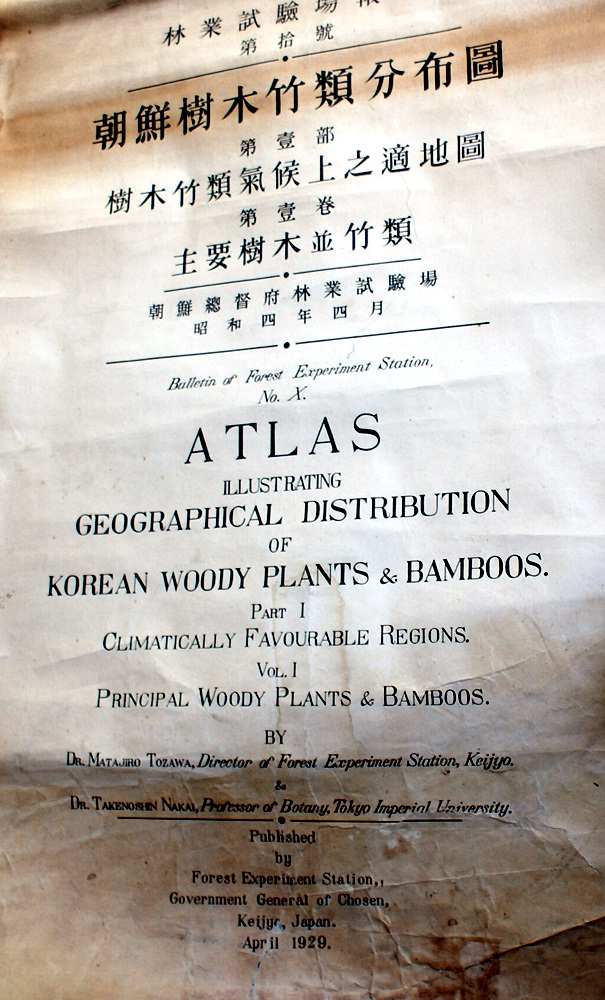
| |
조선수목죽류분포도 1929년 4월 조선총독부임업시험장 제작(총 28장) 58X92CM
/1929
朝鮮樹木竹類分布圖 제1부 . 樹木竹類氣候上之適地圖 제1권 主要樹木竝竹類.총 28장으로 illustrating GEOGRAPHICAL DISTRIBUTION OF KOREAN WOODY PLANTS & 8AMBOOS. Parts 1 Climatically Favourable Regions vol.1 Principal Woody Plants & Bamboos by Dr.Matajiro Tozawa ,Director of Forest Experiment Station,Keijo. Dr.Takenoshin NakaimProfessor of Botany ,Tokyo Imperial Univerity.Published by Forest Experimental Station,Government General of Chosen,Keijo,Japan,.April, 1929...... 겉표지 .차례 등 5장 지도 23장으로 구성됨.
|
조선총독부임업시험장 |
일본어 |
. |
초판 |
8,000,000 원
|
|
|
|
| 62877 |
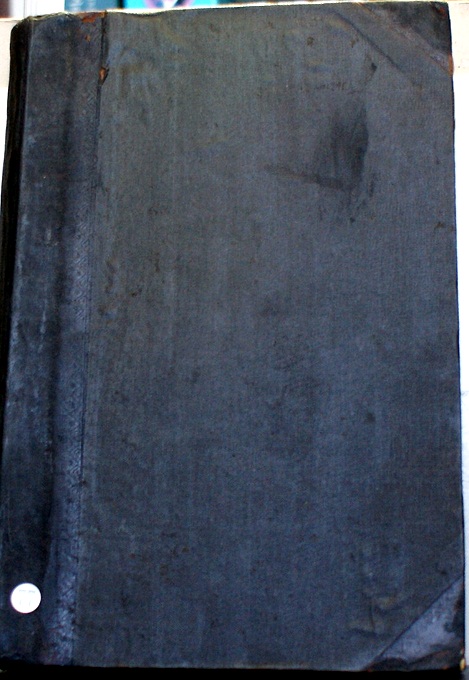
| |
한국의 역사.영문판. The History of Korea(제2권) 1905년 서울발행
/1905
하드커버 .2권 1질중 제 2권임.hard cover, 1905 first and only edition. Illustrated with numerous photographs. Volume 1: 409 pages. Volume 2:374 pages and Index. Based almost wholly on Korean sources,this history covers the period from legandary time,third millenium B.C. to Russo-Japanese War,1905. Because the author has not made much use of western language materials the modern period of Korean history ,especially as regards foreign relations ,is not brought out,as well as the early periods. A chart gives the lsit of Korean Kings,with English and Chinese characters. (Annotation is based on KOREA ,Library of Congress,1950)
|
Homer B.Hulbert |
영어 |
The Methodist Publishing House,Seoul |
초판 |
2,500,000 원
[품절]
|
|
|
|
| 61997-1 |
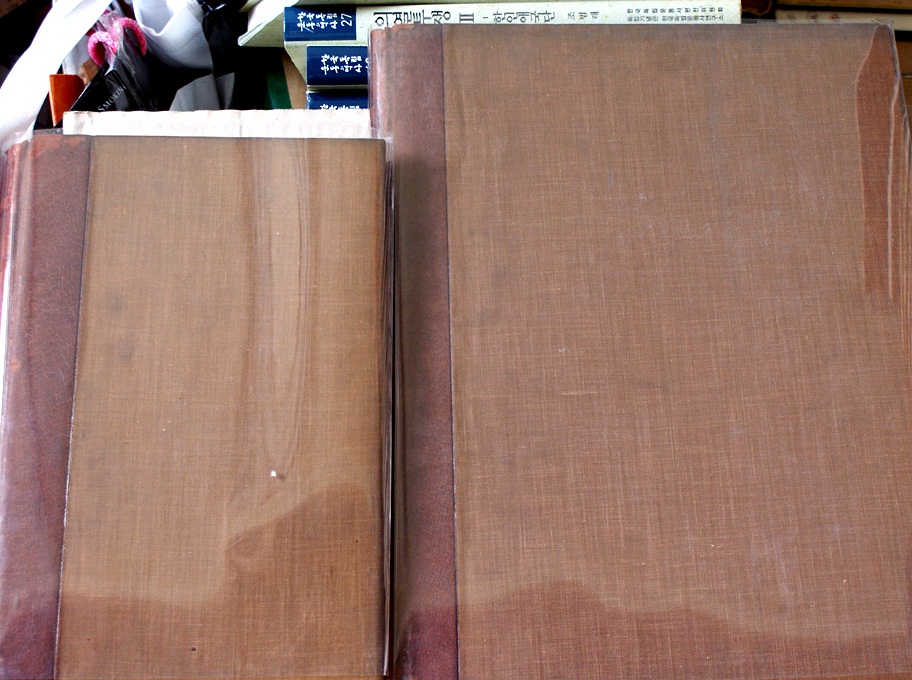
| |
독도자료 2권1질.삼국통람도설 (본책 1권 지도책1권:컬러지도 5장 도판 2장) 1832년 프랑스발행 三國通覽圖設 SAN KOKF TSOU RAN TO SETS ou apercu general des TROIS ROYAUMES.
/1832
.2권1질.본책 1권 지도책1권:컬러지도 5장과 한글자모도판 1장 포함 도판 2장) 1832년 프랑스발행 三國通覽圖設 SAN KOKF TSOU RAN TO SETS ou apercu general des TROIS ROYAUMES...............5장의 지도 명칭과 크기: 1. Carte des TROIS ROYAUMES(74 x 53 cm) 2. Carte des HUIT PROVINCES DU TCHAO SIAN (74 x 53 cm) 3. Carte de L'ILE DE IESO (94 x 53 cm) 4. Carte des ILES RIOUKIOU(74 x 53 cm) 5. Carte des ILES INHABITÉES OU MOU NIN SIMA appellées aussi O GASSA WARA SIMA 66 x 32 cm). (조선-북해도- 유구소개서)Oriental Translation Fund, London, 1832. contemporary backed Buckram. Book Condition: Good. First Edition. 4to - over 9¾" - 12" tall. Volume I: Text: 8 vo. vi, [1], 288 pp. / Volume II: 4to. Plates & Maps, 5 colour folding maps + 2 plates, subscribers leaf for the Athenaeum bound before title, translated from original Japanes-Chinese, gilt, small library stamp verso title page, slightly rubbed with some wear, small loss to spine of volume이책은 일본의 실학자였던 林子平이1785년 일본어로 출판했던 삼국통람도설을 독일인 동양학자였던 KLAPROTH 가 1832년 파리에서 프랑스어로 출판한 초판으로 당시 일본과 인접에 있던 朝鮮,北海島,琉球의 지명과 언어에 대한 연구서임. 저자 임자평은 독도를 조선의 영토로 인정하고 그에 대한 지도를 이 책자에서 발표한바 있음. 이 책자에서 조선을 맨처음 다루고 있으며 전체 288쪽 가운데 조선편은 처음부처 168쪽 까지이며 조선의 중요한 수백개의 지명을 설명하고 있으며 당시 조선에서 사용되었던 조선語를 124쪽부터 144쪽까지 많은 지면을 할애하여 약 500여 단어를 다루고 있음. 조선의 지리와 언어연구에 필수적인 극히 희귀한 자료임.............2010년 6월 18일 현재 인터넷으로 연결되는 전세계고서점유일본이며 국제시세는 10,000달러 정도임.Paris Printed for the Oriental Translation Fund of Great Britain and Ireland. 1832, 1832. Illustrated Survey of the Three Kingdoms Complete with Five Folding, Hand-Colored Maps KLAPROTH, Julius von, [translator]. San kokf tsou ran to sets, ou apercu general des trois royaumes . ouvrage accompagne de cinq cartes. Paris: Printed for the Oriental Translation Fund of Great Britain and Ireland, 1832. First Western edition. Octavo (9 3/4 x 6 1/4 inches; 248 x 158 mm.). [2], vi, [2], 288 pp. With a large quarto album (12 9/16 x 9 3/4 inches; 320 x 248 mm.) complete with a printed title-page and seven engraved plates, five of which are hand-colored folding maps. Contemporary quarter brown morocco over marbled papers, spine stamped and lettered in gilt in compartments, top edges gilt. Album with marbled endpapers, octavo with uncut fore-edge. Corners bumped on both; light browning to octavo. Minor splits along folds of some of the maps. Overall a very good copy with clean, bright maps. First written in Japanese and rendered in Chinese characters in 1785, this is the first Western edition of Rinsifee's San kokf tsou ran to set, or "Illustrated Survey of Three Kingdoms," edited and translated into French by German Orientalist Julius von Klaproth. Although certainly an able interpretation and impressive work of scholarship, this edition is most extraordinary for its large quarto album, which includes five magnificent hand-colored, engraved maps: "Carte de Iles Inhabites ou Mou Nin Sima"; "Carte de L'Ile de Ieso"; "Carte des Trois Royaumes"; "Carte des Iles Riou Kiou"; and "Carte des Huit Provinces du Tchao Sian." All of the maps are folding; the largest folds out to 21 1/4 x 28 1/2 inches, or 540 x 725 mm. Published in Edo, Japan at the end of the eighteenth-century, San kokf tsou ran to sets was written by Hayashi Shihei (1738-1793), a Japanese military stragetist, explorer, and writer also known as Rinsifee. In this book, Rinisfee recounts an exploratory survey of the geography of the regions that were then the frontiers of Japan, including Korea, Hokkaido, and the Ryukyu Islands, and provides descriptions of the inhabitants, including the Ainu. Anticipating European infiltration of Japan, in later works Rinisfee would advocate for improved defenses along Japanese frontiers and a stronger maritime presence. German Orientalist and explorer Julius von Klaproth (1783-1835) published several dozen translations during his lifetime but is probably best known for his 1823 work Asia polyglotta nebst Sprachatlas, one of the first linguistic surveys of Oriental languages. Cordier 2946.
|
Hayashi, Shihei(林子平,日本人1738-1793 ) KLAPROTH, Heinrich J. translator(German Orientalist1783-1835) ) 번역 |
불어 |
Printed for the Oriental Translation Fund of Great Britain and Ireland,Paris |
초판 |
13,500,000 원
[품절]
|
|
|
|
|
| 21213 |
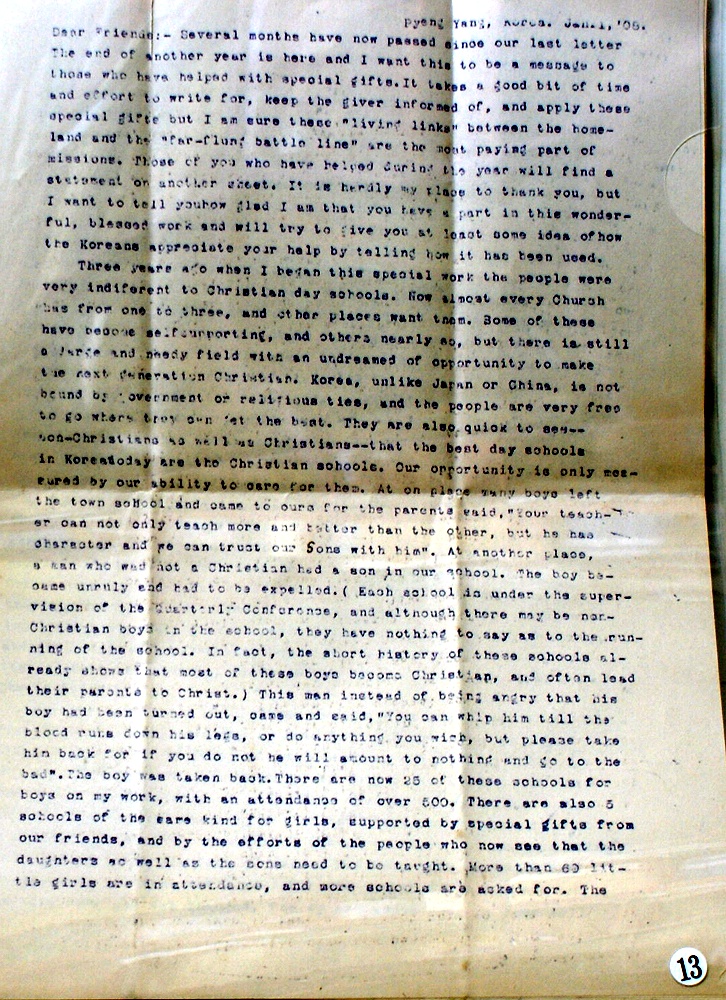
| |
1907년 8년 조선 기독교관련편지 2통.(1907 & 1908 LETTERS FROM MOORE JOHN Z. MISSIONARY KOREA)
/1907
1907년 편지(6쪽) 1908년 편지(4쪽) .......2 letters written by John Z. Moore, a Missionary in Korea. Mr. Moore was part of a contingent of Missionaries of the Missionary Society of the Methodist Episcopal Church. Mr. Moore, I believe, was from St. Clairsville, Ohio. One letter is dated 1907, uses 6 pages, and addressed to Miss Frost. Writer mentions what looks like Basking Ridge, and tells about how his Church and Bible work is going in Korea. I can't make out the city in which this letter was written. The second letter was typewritten at Pyeng Yang, Korea, January 1, 1908. Some of the type has faded, but is still readable, especially for someone with better eyes than mine. 3 pages of this New years Day written letter are typed and there is a manuscript letter on the last page. The typed letter was addressed "Dear Friends" and the manuscript addressed "My Dear Miss Frost". One thing this letter mentions is how much progress has been made since he arrived in Korea 3 years ago, and how much is yet to be done and accomplished. The paper on which this letter is written has rough top edges, age yellowing and staining and the aforementioned fading type. There are no covers, or envelopes, with the letters.
|
MOORE JOHN Z. |
영어 |
. |
초판 |
400,000 원
[품절]
|
|
|
|
| 16349 |
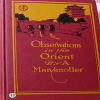
| |
캐도록자료 Observations in the Orient, 1919년 뉴욕초판(사진 79장 포함)/1919
하드커버.323쪽.Maryknoll's first missioners left for China in 1918 to create missionaries, and evangelize the Eastern people. These logs are illustrated with 79 full page photographs of their experiences. A fascinating first hand account of early 20th Century missionary work, and how the men and women struggled to establish themselves in very remote parts of the Far East. Chapters include the missions departure from San Francisco; their sea voyage; Island Empire; Northward to Nikko and Sendai; Touring through the Dioceses; Korea; Manchuria to Tientsin; With the Lazarists in Peking and Chengtingfu; Franciscan Hospitality at Hankow; Up the Yangtze to Shanghai, etc. Maryknoll was established in 1911 as the Catholic Foreign Mission Society of America by the Bishops of the United States.Two diocesan priests, Fr. James Anthony Walsh of Boston and Fr. Thomas Frederick Price of North Carolina, were responsible for it's development of the commission to recruit, send and support U.S. missioners in areas around the world. On June 29, 1911, Pope Pius X blessed the founding of Maryknoll. Today there are over 550 Maryknoll priests and Brothers serving in countries around the world, principally in Africa, Asia and Latin America. |
james S. Walsh |
영어 |
Catholic Foreign Society of America |
초판 |
80,000 원
[품절]
|
|
|
|
| 14194 |
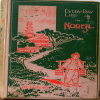
| |
Every-Day Life in KOREA ,A Collection of Studies and Stories.1898년 미국초판.
/1898
hard coverr, 8 vo. 231 pages.First Edition. Illustrated with balck and white photographs. Eevery-Day Life in Korea is a collection of studies and stories by the American Presbyterian missionary Rev. Daniel L. Gifford who served in that country for eight years until 1893. When East Asia was first exposed to the Western world in the late 19th century, many Western observers shared the view that Korea was basically a land of scholars, compared to the militaristic Japan and the commercial China. Steeped in orthodox Confucian principles, its people looked down upon swordsmanship and commerce, and regarded the mastering of Confucian classics for state exams as the only means of establishing one's name and climbing the social ladder. Gifford wrote about this ineffectual education system in this 1898 classic. He also has quite a bit to say about the drinking (excessive) habits of the Koreans. An 1898 review of the book commented: “This is one of the few books on Korea which is worth reading, and brings the everyday life of the common people in this strange land pleasantly before us. Mr. Gifford has studied the life of the Koreans to good purpose, and touches apparently almost every feature and characteristic of that people who are half way between China and Japan in their life and religion as well as in their geographical situation.” Gifford and his wife apparently returned to Korea and died there in 1900. They are buried in a cemetery in Seoul
|
D.L.Gifford |
영어 |
Fleming H.Revell Company,Chicago |
초판 |
500,000 원
[품절]
|
|
|
|
|
|
|
|
| 9336 |
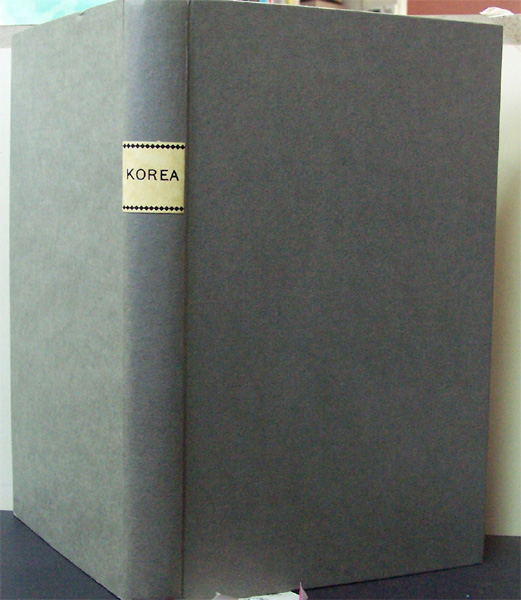
| |
三國通覽圖設 ,1832년 파리초판. (조선-북해도- 유구소개서)SAN KOKF TSOU RAN TO SETS ou apercu general des TROIS ROYAUMES./1832
이책은 일본의 실학자였던 林子平이1785년 일본어로 출판했던 삼국통람도설을 독일인 동양학자였던 KLAPROTH 가 1832년 파리에서 프랑스어로 출판한 초판으로 당시 일본과 인접에 있던
朝鮮,北海島,琉球의 지명과 언어에 대한 연구서임. 저자 임자평은 독도를 조선의 영토로 인정하고 그에 대한 지도를 이 책자에 발표한바 있으나 이 책자에선 지도는 결실되어 없음.
이 책자에서 조선을 맨처음 다루고 있으며 전체 288쪽 가운데 조선편은 처음부처 168쪽 까지이며 조선의 중요한 수백개의 지명을 설명하고 있으며 당시 조선에서 사용되었던 조선語를 124쪽부터 144쪽까지 많은 지면을 할애하여 약 500여 단어를 다루고 있음. 조선의 지리와 언어연구에 필수적인 극히 희귀한 자료임.
Paris Printed for the Oriental Translation Fund of Great Britain and Ireland. 1832, 1832. Illustrated Survey of the Three Kingdoms Complete with Five Folding, Hand-Colored Maps KLAPROTH, Julius von, [translator]. San kokf tsou ran to sets, ou apercu general des trois royaumes . ouvrage accompagne de cinq cartes. Paris: Printed for the Oriental Translation Fund of Great Britain and Ireland, 1832. First Western edition. Octavo (9 3/4 x 6 1/4 inches; 248 x 158 mm.). [2], vi, [2], 288 pp. With a large quarto album (12 9/16 x 9 3/4 inches; 320 x 248 mm.) complete with a printed title-page and seven engraved plates, five of which are hand-colored folding maps. Contemporary quarter brown morocco over marbled papers, spine stamped and lettered in gilt in compartments, top edges gilt. Album with marbled endpapers, octavo with uncut fore-edge. Corners bumped on both; light browning to octavo. Minor splits along folds of some of the maps. Overall a very good copy with clean, bright maps. First written in Japanese and rendered in Chinese characters in 1785, this is the first Western edition of Rinsifee's San kokf tsou ran to set, or "Illustrated Survey of Three Kingdoms," edited and translated into French by German Orientalist Julius von Klaproth. Although certainly an able interpretation and impressive work of scholarship, this edition is most extraordinary for its large quarto album, which includes five magnificent hand-colored, engraved maps: "Carte de Iles Inhabites ou Mou Nin Sima"; "Carte de L'Ile de Ieso"; "Carte des Trois Royaumes"; "Carte des Iles Riou Kiou"; and "Carte des Huit Provinces du Tchao Sian." All of the maps are folding; the largest folds out to 21 1/4 x 28 1/2 inches, or 540 x 725 mm. Published in Edo, Japan at the end of the eighteenth-century, San kokf tsou ran to sets was written by Hayashi Shihei (1738-1793), a Japanese military stragetist, explorer, and writer also known as Rinsifee. In this book, Rinisfee recounts an exploratory survey of the geography of the regions that were then the frontiers of Japan, including Korea, Hokkaido, and the Ryukyu Islands, and provides descriptions of the inhabitants, including the Ainu. Anticipating European infiltration of Japan, in later works Rinisfee would advocate for improved defenses along Japanese frontiers and a stronger maritime presence. German Orientalist and explorer Julius von Klaproth (1783-1835) published several dozen translations during his lifetime but is probably best known for his 1823 work Asia polyglotta nebst Sprachatlas, one of the first linguistic surveys of Oriental languages. Cordier 2946.
|
Hayashi, Shihei(林子平,日本人1738-1793 ) KLAPROTH, Heinrich J. translator(German Orientalist1783-1835) ) |
불어 |
Printed for the Oriental Translation Fund of Great Britain and Ireland,Paris |
초판 |
3,500,000 원
|
|
|
|
| 8958 |
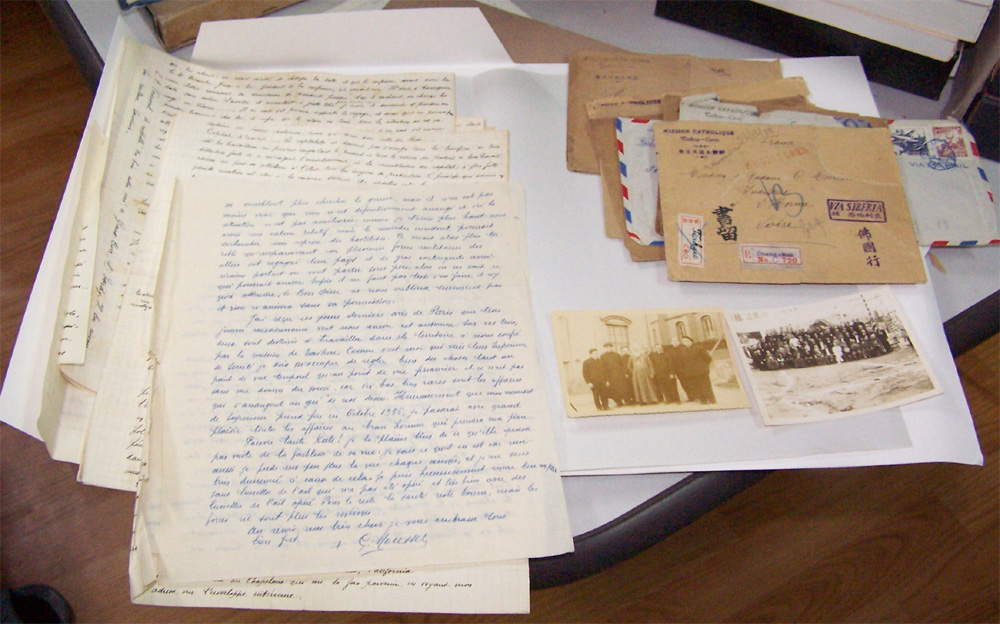
| |
朝鮮大邱天主堂 에서 40년동안(1917-1955) 봉사한 프랑스신부의 친필편지 18통과 사진 2장/1917
대구지역에서 40년간 근무했던 프랑스 신부(Mousset Germain :1876 1957)이 남긴 친필편지 18통과 사진2장 13장의 편지봉투(그중 9통은 朝鮮大邱天主堂라는 stamp 가 찍혀있음.)Museum Quality catholic materials of Mousset Germain (1876 1957: who lived in Korea from 1917 to 1955 ?) 1) 3 letters from France before he left for Korea in 1917.(October 14,1917/October 30,1917November 26,1917) 2) December 14,1917 from Taikou(Daeku),Korea 3) July 14,1919 from Daeku,Korea 4)December 8,1923 fro Daeku,Korea 5)January 11,1924 from Daeku,Korea 6)December 8,1927 from Daeku,Korea 7)December 2,1928 from Daeku,Korea 8)May 11,1932 from Daeku,Korea 9)May 16,1932 from Daeku,Korea 10)October,29 1935 from Saigon,Vietnam 11)November 22,1935 from Daeku,Korea 12)September 13,1936 from Daeku,Korea 13)November 10,1936 from Daeku,Korea 14)January 24,1946 from Daeku,Korea 15)May 23,1955 from Seoul,Korea 16) July 11,1955 from Seoul,Korea --------------------------------------- 17) 2 original photographs(size: 10.5x8cmand 10x17cm ) 18) 13 used letter envelopes( 9 envelopes stamped Mission catholique Taikou-Coree(朝鮮大邱天主堂 ,one envelope handwritten by Mousset Germain from Seoul,Korea. 3 used envelopes without postal address)
|
Mousset Germain (1876 1957) |
불어 |
. |
초판 |
6,000,000 원
[품절]
|
|
|
|
| 8230 |

| |
아주 희귀한 한국식물연구자료. 1886년-1905년간 런던발행 18권.The Journal of The Linnean Society (Botany) vol.23 no.151...
/1886
paperback, small 8 vo. An Enumerration of allthe Plants known from China Proper,Formosa, Hainan,COREA ,the Luchu Archipelago,and the land of Hongkong,together with their Distribution and Synonymy .By Francis Blackwell Forebs,F.L.S., Knight Commandor of Swedish Royal Order of Wasa; And Wiiliam Botting Hemsley,F.R.S., F.L.S., Honorary Member of The Mexican Natural History Society ,Keeper of Herbarium of Royal Gradens. Volume 23. no151-1(1886) Volume 23 no.151-2(1886) Volume 23 no.152(1887) Volume 23 no.153/154(1887) Volume 23 no.155(1888) Volume 23 no.156/157(1888) Volume 26. no. 173(1889) Volume 26. no.174( 1890) Volume 26. no.175 (1890) Volume 26. no. 176(1891) Volume 26 no.177(1894) Volume 26. no.178(1899) Volume 26. no.179/180(1902) Volume 36.No. 251(1903) Volume 36. no.252(1903) Volume 36.no. 253(1904) Volume 36. no.254(1904) Volume 36. no. 255/256(1905) ...........
...........................
린네 (Carl von Linné 1707∼1778):스웨덴 식물학자. 남부 라슐트 출생. 린네는 귀족이 되고 나서의 이름이며, 원래는 라틴식으로 카롤루스 린내우스(Carolus Linnaeus)라고 하였다. 목사인 아버지로부터 일찍이 식물이름을 배웠으며, 지방의 중심도시 벡시외의 기숙학교를 거쳐 룬드대학·웁살라대학에서 의학을 공부하고 식물학에 열중하였다. 식물의 생식법에 관심을 갖고 그것을 시의 형식으로 기록한 것이 식물학교수 O. 루드벡의 주목을 끌어 재능을 인정받았다. 웁살라과학협회에서 계획한 라플란드의 자연조사를 혼자서 한 뒤, 네덜란드에 유학하여 석학 H. 부르하페를 비롯한 많은 명사들과 사귀고 그 때까지의 연구 성과들을 출판했다. 제1작 《자연의 체계(1735)》에서 수술의 성질에 따라 강(綱)을, 암술의 성질에 따라 목(目)을 분류하여 그 분류법으로 주목을 받았다. 또한 J.P. 투르느포르가 수립한 속(屬)의 개념을 받아들여 종명(種名)을 속명과 이를 한정된 몇 단어의 라틴어로써 표시했는데, 그 뒤 편의를 위해 한정하는 단어 중 한 단어를 취해 소명(小名)으로 하였다. 이것이 학명의 시초이며 이 방법은 2명법(二名法)이라 불리게 되었다. 이에 따라 학명을 단 하나의 정명(正名)으로 하고, 다른 호명(呼名)은 이명(異名)으로 하여 1종에 1명(名)을 정하게 되었다. 이후 국제회의에서 식물은 린네의 《식물의 종(種, 1753)》에서 동물은 《자연의 체계》 제10판(1758)에서 각각 학명을 채용할 것이 결정되었다. 린네는 당시까지 알려진 동·식물 전부를 유용·무용의 구별 없이 모두 동일하게 명명·기술하여 목초학(木草學)으로부터 탈피한 근대식물학의 체계를 세웠다. 이 체계는 마침내 자연분류에도 적용되어 오늘날에 이르고 있다. 1742년 이래 웁살라대학의 식물학교수를 역임했다. 그가 사망한 뒤 1788년 J.E. 스미스가 린네를 기념하여 런던에 린네학회를 설립하고 초대회장이 되었다. 린네의 표본이나 장서(藏書)는 스미스가 개인적으로 사들인 것을 사망 후에 학회가 매입하고 표본관과 도서관을 설립하여 보존해 오고 있다.(이상 www.yahoo.co.kr에서 인용함)
|
The Linnean Society |
영어 |
. |
초판 |
1,800,000 원
[품절]
|
|
|
|
| 2303 |

| |
1670년 발행 하멜표류기 불어초판.HAMEL, Hendrik. Relation du naufrage d''un vaisseau Holandois, sur la coste de l''Isle de Quelpaerts: avec la description du Royaume de Coree. Traduite du flamand, par Monsieur Minutoli(1670년 발행 하멜표류기 불어초판)
조선일보(2004년 1월 13일자 20면) 참고요함/1670
'하멜표류기' 1670년 불어 초판 국내 입수
17세기 조선의 사정을 담은 기행문 ‘하멜 표류기’의 1670년 프랑스어 초판< 사진 >이 국내에 입수됐다. 고서 상인 윤형원(尹亨源) 아트뱅크 대표는 최근 네덜란드 고서점으로부터 구입한 이 책을 12일 공개했다.
이 책은 1668년 ‘하멜 표류기’의 네덜란드 초판이 나온 지 2년 뒤 미뉘톨리(Minutoli)가 프랑스어로 번역한 것으로, 제목은 ‘제주도 해안에서의 네덜란드 배의 난파에 대한 보고서: 조선 왕국에 대한 묘사와 함께(Relation du Naufrage d’un Vaisseau Holandois, Sur la Coste de l’Isle de Quelpaerts: Avec la Description du Royaume de Cor eㆍ토마 졸리ㆍ168쪽)다. 그동안 국내에 입수된 ‘하멜 표류기’ 최고본(最古本)은 명지대 LG연암문고가 소장한 1672년 독일어 초판이었다.
Exceedingly rare book .The eyewitness Hendrik Hamel as the first European in Korea. Paris, Thomas Jolly, 1670. 12mo. Contemporary mottled calf, spine gilt in compartments, red sprinkled edges. (8), 165, (1, 2 blank) pp. First edition in French of an account of a stay of thirteen years in Korea by Hendrik Hamel, translated into French by Vincent Minutoli (ca. 1640 in Geneva -1710), a reformed minister in Holland and close friend of Pierre Bayle, who has translated also other Dutch travel accounts. There are also copies of his translation with the imprint ''Paris, L. Billaine, 1670'' with the name of the author on the title-page. In 1718 this translation was reprinted in Amsterdam in J.F. Bernard''s Recueil de voyages au Nord, vol. IV, p. 1-82 (and in the 1732 ed., vol. IV, p. 243-306, as well as in vol. VIII of Ant. F. Pr?ost d''Exiles''s Histoire g??al des voyages, p. 412-429.Hamel sailed as the ship''s secretary from Texel to Batavia on ''De Sperwer'' in January 1653. After visiting Batavia and Formosa, the ship set sail for Japan with the newly appointed V.O.C. governor for Korea, Cornelis Lessen, on board. Unfortunately the ship wrecked at the coast of an unknown island near Korea, which they named the Isle of Quelparts. Many of the crew drowned. Those who survived, including Hamel, went ashore, where they were imprisoned by the Koreans and brought to the main land where they were held for no less than thirteen years. In 1666 Hamel and a few of his companions succeeded to escape and they managed to reach Japan. In 1668 they arrived back in the Netherlands. Still in the same year the account of his misadventures was published at Rotterdam by Joh. Stichter. Hamel''s account, which is the first Western eyewitness of Korea, became very popular, and was not only translated into French, but also, in 1732, into English with the title An account of the shipwreck of a Dutch vessel on the coast of the Isle of Quelpaert. Good copy of a rare popular book with ownership''s entry on the title: ''De Ressevel''. Pag?, Bibl. Jap. 316; Polak 4284; Chadenat 1617, 3766; Tiele 449 (issue printed by Billaine, not mentioning the present issue); Tiele, M?oire p. 271-5; Cordier, Japonica 404; Alt-Japan Kat. 626 (the 18th-cent. editions). First edition of this title in Dutch was published in 1668 in Netherlands. Hamel's account gave the West its first direct knowledge of Korea. In 1593, a Spanish Jeuit ,Father de Cespedes ,had accompanied the Japanese troops of Toyotomi Hideyoshi during their invasion of Korea. But in their annual letters to their superior in Europe ,the Jesuits of Japan just related the campaign without carrying to include information on the country and its inhabitants. Fr.de Guzman used these letters in his Historia(1601) adding generally confusing infomation on Korea of Chinese origin. The reason for this ignorance was the strict rules prohibiting foreigners to enter Korea and the European navigators,who were trading with Japan,avoided sailing near the penininsula. In 1627,a VOC ship ,the Ouderkerk,having gone near the coast,sent a canoe to fetch some fresh water and three sailors who were aboard were captured by the inhabitants.One of them,Jan Janse Weltervree,who had taken the name Pak Yon,was still alive when Hamel and his companions were stranded on Cheju (Quelpaert) Island in 1653. The VOC vessel Sperwer left Batavia on June 18th 1653 with sixty-four men on board .Hendrik hamel waa the ship's "Secretary" .In August the vessel was caught in a severe storm and twenty-eight of the crew perished. The survvors were interened and subsequently transferred to Seoul. It was at Quelpaert,while waiting for a long time for orders from the court concerning the fate,that Hamel and his companions met Jan Weltevree who acted as translator for them. It was from him they learnt that onece in Korea one could not escape.It was on in 1666,after thirteen years ,when the supervision had relaxed ,that Hamel and seven of his companions could get hold of boat and were carried towards the Japanese island of Kyusu by the winter monsoon.In nagasaki,the rescued sailors were questioned at length by the Japanese and by the Director of the Deshima factory,Their answers,taken down in the company register dated Septrember 14th,1666,match the account which Hamel started writing at once. The last image is The Chosun Ilbo,January 13,2004 ( one of the largest and leading daily newspaper in Korea) reporting this book. ***** A New Version of Hamel's Old Book by Yoo Seok-jae (karma@chosun.com) The first edition of the "Journal of Hamel" published in 1670 in French, has come to Korea. Yoon Hyoung-won, the CEO of an antiquarian bookseller Art Bank, disclosed the first French edition of the journal on Monday. Yoon said he recently purchased the book from a Dutch antiquarian bookseller. Hendrick Hamel was a Dutch explorer and the first Westerner to discover Korea. His journal on Korea is significant in that it was the first book to introduce Korea to the Western world. The edition is a translated version of the original Dutch edition of the Journal of Hamel in 1668. It was translated into French by Minutoly. The English title of the 168-page version is "Report of the Shipwreck of a Dutch Vessel On the Cost of Jeju Island: With the Description of the Kingdom of Coree by Thomas Jolly." Previously, the oldest version of the Journal of Hamel had been the first edition in German published in 1672, owned by Myungji University and the LG Yonam Foundation. ***************************************************************
|
Hamel Hendrik |
불어 |
Paris, Thomas Jolly |
|
0 원
[품절]
|
|
|
|
|
| 3097 |
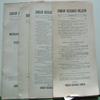
| |
애국가에 대한 새로운 자료(조선일보 2005년 6월 23일자 23면 기사 참조)Korean Research Bulletin Volume 1 Number 1, 2 ,,Volume 2 Number 1-2( 1943-1944)/1943
창간호 포함 3권이며 새로운 애국가 자료포함하고 있슴.
안익태가 애국가의 작곡을 하게 된 이유,.(인테넷으로 연결되는 전 세계고서점중 유일본...2004년 9월20일 현재).....................................................................................................................[Los Angeles 1943, Korean Research Council. ] Paper wrappers, very good,8vo. 32p, ......................................................................................................................한글·영어 병기 애국가 악보
1943년 미 '한국인 연구회보'에 실려… 새로 발굴 .................................................................. (조선일보 2005년 6월 23일자 인용)
입력 : 2005.06.22 17:47 17' / 수정 : 2005.06.22 23:57 12'
미국에서 한글과 영어를 병기해 간행한 애국가 악보(1943년 9월)가 새로 발굴됐다. 현전하는 애국가 악보 중 1936년 6월 미국에서 발간된 애국가 악보 다음으로 오래됐다. 애국가 악보는 조선총독부 경무국이 ‘금지단행본’으로 지정한 까닭에 광복 전 악보는 모두 해외에서만 나왔다. 현재까지 전하는 애국가 악보는 모두 4개다.
근현대사료수집가 윤형원 아트뱅크 대표가 22일 공개한 이 악보는 로스앤젤레스에서 운영되던 한국인연구위원회(Korean Research Council)가 계간으로 간행한 ‘한국인연구회보(Korean Research Bulletin)’ 1943년 9월호 첫 페이지에 실려 있다. 애국가 가사를 4절까지 한글로 기록한 뒤, 애국가 1절 가사를 ‘Dong hai mool gwa Paik doo san i…’로 발음나는 대로 알파벳으로 적었다.
애국가는 안익태가 1935년 11월, 미국 필라델피아에서 작곡했다. 안익태는 미국에서 발행되던 한국어 주간신문 ‘신한민보’ 1936년 3월 26일자 기고에서 “1930년 미국 상항(샌프란시스코)에 처음 도착했을 때 가장 깊은 인상을 주었던 것은 그곳 예배당에서 제 일생에 처음 부른 대한국(大韓國) 애국가였다”며 “그러나 이 곡조는 스캇치의 술노래(올드 랭 사인)였다가 나중에 이별가로 불린 것인데, 이를 신성한 애국가 곡조로 부르는 것은 대한국의 수치인 줄 자각해 애국가 작곡을 결심했다”고 밝혔다. 그는 이 글에서 “애국가는 지난 5년 동안의 노력 끝에 1935년 11월 어느 날 이른 아침에 완성했으며, 샌프란시스코에 처음 도착했을 때 한인교회 목사님으로부터 받은 만년필로 작곡했다”고 밝혔다.
‘신한민보’는 애국가 작곡 경위를 밝힌 안 선생의 기고문을 실은 직후인 1936년 6월 18일자에 “이 악보를 받으신 분은 20전(이상)을 출판비조로 아끼지 않고 보내실 줄을 믿는다”는 광고와 함께 애국가 악보를 별지(別紙)로 신문에 동봉해 독자들에게 배포했다. 이 악보가 현재 남은 애국가 악보 중 가장 오래된 것이다.
Vol. 1 No. 1, Jan 1943, bib, Japan's Foreign Policy & Its Setting in the World Today, by Sae Woon Chang. The bulletin discusses various aspects of Korea and it's often changing position in the global theater. There are usually astute references to Japan & Japanese wars, the U.S. as well as things more intimately Korean; the Korean National Anthem, Korean folk songs, Korean geography & agriculture as well as political relations......................Los Angeles 1943, Korean Research Council]. White wrappers, very good, 32p., Vol. 1 No. 2 Sept. 1943. The bulletin discusses various aspects of Korea and it's often changing position in the global theater. There are usually astute references to Japan & Japanese wars, the U.S. as well as things more intimately Korean; the Korean National Anthem, Korean folk songs, Korean geography & agriculture as well as political relations............Los Angeles 1945, Korean Research Council]. White wrappers, very good, 29p., Vol. 2 No's 1 & 2, May 1945, 17 tables, bib-liog. Problems in Agriculture in Post-War Korea by K. S. Yum. The bulletin discusses various aspects of Korea and it's often changing position in the global theater. There are usually astute references to Japan & Japanese wars, the U.S. as well as things more intimately Korean; the Korean National Anthem, Korean folk songs, Korean geography & agriculture as well as political |
Korean Reaserch Council,L.A. |
영어 |
. |
초판 |
2,000,000 원
|
|
|
|
| 5053 |
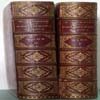
| |
1881년 초판 中國書誌 Bibliotheca Sinica / Dictionnaire Biblopgraphique des ouvrages relatifs a L'empire Chinos (Tome Premier,Tome Second ) /1881/1883/1881
Hard cover, 8 vo. 1408 pages .First edition.(Volume 1 published in1881 and Volume 2 published in 1883 only) A classified bibliography of books and articles in European languages on all fields of Chinese studies. A pioneer and still standard reference work." - Walford. Concentrates on 19th century studies. Arranged in 5 parts, of which the first deals with China as a whole and occupies the first two and a half volumes. The remaining parts cover foreigners in China; relations between China and foreigners; the Chinese in foreign countries; and tributary countries of China. Consisting of 4428 columns of entries, listing thousands of books on China, Tibet, Ryu- Kyu Islands, Corea, Mongolia, Manchuria, Tartary &c. This work organizes the books into genera l subject categories: geographie, names, ethnography, climate, natural history, population, government, jurisprudence, history, religion, missionary work, sciences & art, language & literature, cus- toms, voyages, travels, commerce, ports, commerce &c. A most valuable reference book, indespensible tool for any student of Chinese art, culture, history etc.
|
Henri CORDIER |
불어 |
Ernest Leroux Editeur,Paris |
초판 |
5,000,000 원
|
|
|
|
| 3097 |
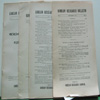
| |
애국가에 대한 새로운 자료(조선일보 2005년 6월 23일자 23면 기사 참조)Korean Research Bulletin Volume 1 Number 1, 2 ,,Volume 2 Number 1-2( 1943-1944)/1943
창간호 포함 3권이며 새로운 애국가 자료포함하고 있슴.
안익태가 애국가의 작곡을 하게 된 이유,.(인테넷으로 연결되는 전 세계고서점중 유일본...2004년 9월20일 현재).....................................................................................................................[Los Angeles 1943, Korean Research Council. ] Paper wrappers, very good,8vo. 32p, ......................................................................................................................한글·영어 병기 애국가 악보
1943년 미 '한국인 연구회보'에 실려… 새로 발굴 .................................................................. (조선일보 2005년 6월 23일자 인용)
입력 : 2005.06.22 17:47 17' / 수정 : 2005.06.22 23:57 12'
미국에서 한글과 영어를 병기해 간행한 애국가 악보(1943년 9월)가 새로 발굴됐다. 현전하는 애국가 악보 중 1936년 6월 미국에서 발간된 애국가 악보 다음으로 오래됐다. 애국가 악보는 조선총독부 경무국이 ‘금지단행본’으로 지정한 까닭에 광복 전 악보는 모두 해외에서만 나왔다. 현재까지 전하는 애국가 악보는 모두 4개다.
근현대사료수집가 윤형원 아트뱅크 대표가 22일 공개한 이 악보는 로스앤젤레스에서 운영되던 한국인연구위원회(Korean Research Council)가 계간으로 간행한 ‘한국인연구회보(Korean Research Bulletin)’ 1943년 9월호 첫 페이지에 실려 있다. 애국가 가사를 4절까지 한글로 기록한 뒤, 애국가 1절 가사를 ‘Dong hai mool gwa Paik doo san i…’로 발음나는 대로 알파벳으로 적었다.
애국가는 안익태가 1935년 11월, 미국 필라델피아에서 작곡했다. 안익태는 미국에서 발행되던 한국어 주간신문 ‘신한민보’ 1936년 3월 26일자 기고에서 “1930년 미국 상항(샌프란시스코)에 처음 도착했을 때 가장 깊은 인상을 주었던 것은 그곳 예배당에서 제 일생에 처음 부른 대한국(大韓國) 애국가였다”며 “그러나 이 곡조는 스캇치의 술노래(올드 랭 사인)였다가 나중에 이별가로 불린 것인데, 이를 신성한 애국가 곡조로 부르는 것은 대한국의 수치인 줄 자각해 애국가 작곡을 결심했다”고 밝혔다. 그는 이 글에서 “애국가는 지난 5년 동안의 노력 끝에 1935년 11월 어느 날 이른 아침에 완성했으며, 샌프란시스코에 처음 도착했을 때 한인교회 목사님으로부터 받은 만년필로 작곡했다”고 밝혔다.
‘신한민보’는 애국가 작곡 경위를 밝힌 안 선생의 기고문을 실은 직후인 1936년 6월 18일자에 “이 악보를 받으신 분은 20전(이상)을 출판비조로 아끼지 않고 보내실 줄을 믿는다”는 광고와 함께 애국가 악보를 별지(別紙)로 신문에 동봉해 독자들에게 배포했다. 이 악보가 현재 남은 애국가 악보 중 가장 오래된 것이다.
Vol. 1 No. 1, Jan 1943, bib, Japan's Foreign Policy & Its Setting in the World Today, by Sae Woon Chang. The bulletin discusses various aspects of Korea and it's often changing position in the global theater. There are usually astute references to Japan & Japanese wars, the U.S. as well as things more intimately Korean; the Korean National Anthem, Korean folk songs, Korean geography & agriculture as well as political relations......................Los Angeles 1943, Korean Research Council]. White wrappers, very good, 32p., Vol. 1 No. 2 Sept. 1943. The bulletin discusses various aspects of Korea and it's often changing position in the global theater. There are usually astute references to Japan & Japanese wars, the U.S. as well as things more intimately Korean; the Korean National Anthem, Korean folk songs, Korean geography & agriculture as well as political relations............Los Angeles 1945, Korean Research Council]. White wrappers, very good, 29p., Vol. 2 No's 1 & 2, May 1945, 17 tables, bib-liog. Problems in Agriculture in Post-War Korea by K. S. Yum. The bulletin discusses various aspects of Korea and it's often changing position in the global theater. There are usually astute references to Japan & Japanese wars, the U.S. as well as things more intimately Korean; the Korean National Anthem, Korean folk songs, Korean geography & agriculture as well as political |
Korean Reaserch Council,L.A. |
영어 |
. |
초판 |
2,000,000 원
|
|
|
|
|
|
|
|
|
|
|
| 5646 |
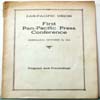
| |
제1회 세계신문인협회 범태평양지역 대회자료.First Pan-Pacific Press Conference ,Honolulu ,October 21,1921
/1921
한국의 금속활자가 독일 구텐베르그 활자보다 빠르다는 내용을 발표한 자료보임.paperback,8 vo. 95 pages. First Edition. Pan-Pacific Union Program and Proceedings / First Pan-Pacific Press Conference. A Regional Section of The Press Congress of the World,Honolulu ,October 21,1921 held under the auspices of the pan-Pacific Union and called by Dr.Walter Williams ,President of the Press Congress of the World. Korea section: from page 69 to 70:The Newspaper in Korea by Dong Soo Kim ,The Dong-A Daily,Seoul,Korea..."History tells us that the Koreans invented the iron moveable types long before GUTENBERG ....." 2005년 10월 12일현재 인터넷으로 인결되는 전세계 고서점 유일본임
|
Pan-Pacific Union |
영어 |
. |
초판 |
300,000 원
|
|
|
|
|
|
|
|
|
|
|
|
|
|
|
|
|
|
|
|
|
|
|
|
| 6388 |
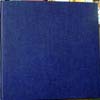
| |
西洋에서 서양어로 번역된 최초의 韓國語本.LUI HO(流合) 1838년 네덜란드에서 독일어로 발행.초판./1838
LUI HO(流合) sive VOCABULARIUM SINENSE IN KORAIANUM CONVERSE ,Opus Sinicum origine in peninsula Korai impressum in Lapide Exaratum a Sinensi KO TSCHING DSCHANG et redditum curante PH.FR.de SIEBOLD........................................................................................................ 조선시대 우리나라 漢字학습서 ‘유합’ (조선일보.2006년 4월11일자 A23면 기사)
1838년 독일어 초판본 발견
“서구에서 최초로 번역된 한국 서적”
서구에 최초로 번역 소개된 한국 서적의 19세기 초 번역본이 발견됐다. 이 책은 독일인 지볼트(Philipp Franz von Siebold·1796~1866·왼쪽 사진)가 1838년 네덜란드 라이덴(Leiden)에서 출간한 ‘유합(類合·Lui H?)’의 초판본으로, 최근 고서점 아트뱅크(koreanamuseum.com)의 윤형원(尹亨源) 대표가 해외에서 입수해 10일 공개했다. 가로 29.5㎝, 세로 37.5㎝의 크기에 42쪽 분량인 이 책은 한자 입문서 ‘유합’의 전문(全文)을 기록하고 글자 양쪽에 뜻과 발음을 나타내는 한글을 함께 적은 뒤, 그 내용을 모두 독일어로 번역했다. 예를 들어 ‘東’에 ‘동녁 동’이라는 뜻과 음을 한글로 적고 뒤에서 ‘Tong(한국 한자 발음) Ost(독일어 뜻) tong nj?k(한국어 뜻)’을 기록했다. 부록으로는 어휘집과 시조, 한시 2편 등이 실렸다.
독일 출신의 의사인 지볼트는 네덜란드 동인도회사의 파견으로 1823년부터 1830년까지 일본 나가사키(長崎)에서 근무했고, 1828년 조선의 난파 선원들을 만난 것을 계기로 우리나라에 관심을 가지기 시작했다. 그가 1852년 출간한 ‘일본(Nippon)’의 제7부에 ‘유합’을 번역한 내용이 실렸지만 그 초판이 언제 출간됐는지는 확실하지 않았다. 1989년 지볼트에 대한 논문을 썼던 고영근(高永根) 서울대 명예교수는 “1838년의 초판본은 지금까지 확인된 적이 없었다”며 “이번에 발견된 책은 서구에서 가장 먼저 번역된 한국 서적이라는 의미가 있다”고 말했다. 이보다 3년 앞선 1835년 영국 선교사 메드허스트가 한국 서적 ‘왜어유해’ 등을 번역한 ‘조선위국자휘(朝鮮偉國字彙)’를 냈지만 유럽이 아닌 인도네시아에서 출간됐다.
조선 초기에 쓰인 ‘유합’은 1500여 자(字)를 담고 있으며, 조선시대 ‘천자문’과 쌍벽을 이룬 한자 학습서였다. 손희하(孫熙河) 전남대 국문과 교수는 “‘유합’은 중국에서 나온 ‘천자문’과는 달리 우리 고유 문화를 풍부하게 담고 있는 책”이라며, “지볼트의 번역본은 19세기 초의 남부 방언을 담고 있는 귀중한 자료로, 당시 서구인들이 이를 통해 한국의 언어와 문화를 접하고 학습했다는 것을 알 수 있다”고 말했다.
--------------------------------------------------------------------------------
hardcover, 29x38cm. 38 pages in Korean,Chinese,Japanese and German.First Korean book translated and published in western languages in Europe. Lew Hap (LUI HO)is a kind of Korean book dedicated to helping Korean Children to study the introduction and basic course of Chinese Characters from the early times in Chosen Dynasty .Extremely rare source on the linguistics of Korean Language......................................................Philipp Franz von Siebold: Philipp Franz Balthasar von Siebold (February 17, 1796 in Würzburg - October 18, 1866 in Munich) was a German physician. He emerged as the first European to teach Western medicine in Japan. He obtained significance for his study of Japanese flora and fauna that were endemic to the unique biotic island landscape...................................................... EARLY LIFE: Born in Würzburg, Bavaria into a family of doctors and professors of medicine, von Siebold initially studied medicine at the university of his hometown from November 1815. One of his professors was Franz Xaver Heller (1775-1840), author of the Flora Wirceburgensis (flora of the Grand Duchy of Würzburg, 1810-1811). Ignaz Döllinger (1770-1841), his professor of anatomy and physiology, however, most influenced him. Döllinger was one of the first professors to understand and treat medicine as a natural science. Von Siebold stayed at Dollinger's, where he came in regular contact with other scientists. He read the books of Alexander von Humboldt, a famous naturalist and explorer, which likely raised his desire for travels to far-away, distant lands. Philipp von Siebold became a Doctor by earning his M.D. in 1820. He initially practiced medicine in Heidingsfeld, Germany (now part of Würzburg). Invited to Holland by an acquaintance of the family, von Siebold applied for a position as a military doctor. This position would enable him to travel to the Dutch colonies. He entered Dutch military service on June 19, 1822. He was appointed ship's doctor on the frigate Adriana on the voyage from Rotterdam to Batavia (present-day Djakarta) in the Dutch East Indies (present-day Indonesia). On his trip to Batavia on the frigate Adriana, he practiced his knowledge of the Dutch language and rapidly learned Malay. During the long trip, von Siebold started a collection of sea fauna. He arrived in Batavia on February 18, 1823. As an army medical officer, von Siebold posted with an artillery unit. He stayed, however, a couple of weeks at the residence of the governor-general to recover from illness. With his erudition, he impressed the governor-general baron Van der Capellen and the head of the botanical garden Buitenzorg Caspar Georg Carl Reinwardt. Already, these men witnessed a second Engelbert Kaempfer and Carl Peter Thunberg (author of Flora Japonica), both former resident physicians at Deshima. The Batavian Academy of Arts and Science made von Siebold a member. In Japan................................................................................... Sent to Deshima Island Nagasaki in June 28, 1823, von Siebold arrived August 11, 1823 as the new resident physician and scientist to the island. During his eventful trip he barely escaped drowning during a typhoon in the East-Chinese Sea. Since only a very limited number of Dutch citizens were allowed on this island, the posts of physician and scientist had to be combined. At that time, Deshima was no longer in the possession of the Dutch East Indian Company but was kept running by the Dutch State, because of political reasons. Von Siebold invited Japanese scientists to show them the marvels of western science, learning in return through them much about the Japanese and their customs. After curing a local influential officer, von Siebold gained the ability to leave the trade post. He used this opportunity to treat Japanese patients in the greater area around the trade post. Since mixed marriages were forbidden, von Siebold "lived together" with his Japanese partner Kusomoto Taki (楠本滝). In 1827 Kusomoto Taki gave birth to their daughter, Oine. Later, Oine became the first Japanese "female doctor" and midwife. She died in 1903. Von Siebold used to call his wife "Otakusa" and named a Hydrangea after her. Von Siebold began a medical school with the 50 students, appointed by the Shogun (see Rangaku). They helped the botanical and naturalistic studies of von Siebold. His school, the Narutaki-juku, grew into a meeting place for around 50 Rangakusha. Recognized by the Japanese, von Siebold served as an expert on Western science. The Dutch language became the lingua franca (common spoken language) for these academic and scholarly contacts until the Meiji Restoration. His patients paid him in kind with a whole variety of objects and artifacts that would later gain historical significance. These everyday objects later became the basis of his large ethnographic collection, which consisted of everyday household goods, woodblock prints, tools and hand-crafted objects used by the Japanese people. His main interest, however, focused on the study of Japanese fauna and flora. He collected as much material as he could. Starting a small botanical garden behind his home (there was not much room on the small island) von Siebold amassed over 1,000 native plants. In a specially built glasshouse he cultivated the Japanese plants to endure the Dutch climate. Local Japanese artists drew images of these plants, creating botanical illustrations and images of the daily life in Japan, which complemented his ethnographic collection. He hired Japanese hunters to track rare animals and collect specimens. Many specimens were collected with the help of his Japanese collaborators Ito Keisuke (1803-1901), Mizutani Sugeroku (1779-1833), Ohkochi Zonshin (1796-1882) and Katsuragawa Hoken (1797-1844), a physician to the Shogun. As well, von Siebold's assistant and later successor, Heinrich Bürger (1806-1858), proved to be indispensable in carrying on von Siebold's work in Japan. Von Siebold first introduced to Europe such familiar garden-plants as the Hosta and the Hydrangea otaksa. Unknown to the Japanese, he was also able to smuggle out germinative seeds of tea plants to the botanical garden Buitenzorg in Batavia. Through this single act, he started the tea culture in Java, a Dutch colony at the time. Until then Japan had strictly guarded the trade in tea plants. Remarkably, in 1833, Java already could boast a half million tea plants. During his stay at Deshima, he sent three shipments with an unknown number of herbarium specimens to Leiden, Gent, Brussels and Antwerp. The shipment to Leiden contained the first specimens of the Japanese giant salamander (Andrias japonicus) to be sent to Europe. In 1825 the East Indian Company provided him with two assistants : apothecary and mineralogist Heinrich Bürger (his later successor) and the painter Carl Hubert de Villeneuve. Each would prove to be useful to von Siebold's efforts that ranged from ethnographical to botanical to horticultural, when attempting to document the exotic Eastern Japanese experience. Reportedly, von Siebold was not the easiest man to deal with; as he continuously conflicted with his Dutch superiors, who held against him his superior attitude. This thread of conflict resulted in his recall in July 1827 back to Batavia. But the ship, the Cornelis Houtman, sent to carry von Siebold back to Batavia, was thrown ashore by a typhoon in Nagasaki bay. The same storm badly damaged Dejima and destroyed von Siebold's botanical garden. Repaired, the Cornelis Houtman set afloat. It left for Batavia with 89 crates of von Siebold's salvaged botanical collection, but von Siebold, however, remained behind in Dejima. In 1828 von Siebold made the court journey to Edo. During this long trip he collected many plants and animals. But he also obtained from the court astronomer Takahashi Kageyasu several detailed maps of Japan and Korea (written by Ino Tadataka), an act strictly forbidden by the Japanese government. When the Japanese discovered, by accident, that von Siebold had mapped northern parts of Japan, the government accused him of high treason and of being a spy for Russia. The Japanese ordered von Siebold into house arrest and expelled him from Japan on October 22, 1829. Satisfied that his Japanese collaborators would continue his work, he journeyed back on the frigate Java to his former residence, Batavia, in possession of his enormous collection of thousands of animals and plants, his books and ... his maps. The botanical garden of Buitenzorg would soon house von Siebold's surviving, living flora collection of 2,000 plants. He arrived in the Netherlands on July 7, 1830. His stay in Japan and Batavia had lasted for a period of eight years. Return to Europe.............................................................................. Von Siebold arrived just at a time when, in 1830, political troubles erupted in Brussels, leading soon to the Belgian independence. Hastly he salvaged his ethnographic collections in Antwerp and his herbaria specimens in Brussels and brought them over to Leiden. Unfortunately, he left behind his botanical collections of living plants that were sent to the University of Gent. The consequent expansion of this collection of rare and exotic plants led to the horticultural fame of Gent. Nevertheless, the University of Gent presented him in 1841, in gratitude, specimens of every plant from his original collection. Von Siebold settled in Leiden, taking with him the major part of his collection. The "von Siebold collection," containing many species type specimens, was the earliest botanical collection from Japan. Even today, it still remains a subject of ongoing research, a testimony to the depth of work undertaken by von Siebold. It contained about 12,000 specimens, from which he could describe only about 2,300 species. The whole collection was purchased for a handsome amount by the Dutch government. As well, von Siebold was granted a generous annual allowance by the Dutch King Willem I. In 1842 the King even raised von Siebold to the peerage as an esquire. Title page of Flora JaponicaThe "von Siebold collection" opened to the public in 1831. He founded a museum in his home in 1837. His successor in Japan, the aforementioned Heinrich Bürger, sent him three more shipments of specimens. This flora collection formed the basis of the Japanese collections of the National Herbarium in Leiden and the Museum Naturalis. This museum later grew into the well-known and respected National Museum of Ethnology in Leiden. During his stay in Leiden, he authored Nippon in 1832, the first tome of a richly illustrated ethnographical and geographical work on Japan. It also contained a report of his journey to the Shogunate Court at Edo. Given the scale of von Siebold's other publications, he proved to be quite prodigious; as six more tomes would appear until 1882. More over, the Bibliotheca Japonica appeared between 1833 and 1841. This work was co-authored by Joseph Hoffmann and Kuo Cheng-Chang, a Javanese from Chinese extraction, who had journeyed along with von Siebold from Batavia. It contained a survey of Japanese literature and, in addition, a Chinese, Japanese and Korean dictionary. The zoologists Coenraad Temminck (1777-1858), Hermann Schlegel (1804-1884) and Wilhem de Haan (1801-1855) "scientifically" described and documented von Siebold's collection of Japanese animals. The result led to the Fauna Japonica, a series of monographs published between 1833 and 1850, making the Japanese fauna the best-described non-European fauna - a remarkable feat for von Siebold. Additionally von Siebold produced his Flora Japonica in collaboration with the German botanist Joseph Gerhard Zuccarini (1797-1848). It first appeared in 1835. The completed version, however, did not appear until after his death, finished in 1870 by F.A.W. Miquel (1811-1871), director of the Rijksherbarium in Leiden. This work established von Siebold's scientific fame, not only--and already--in Japan, but in Europe as well. From the Hortus Botanicus Leiden--the botanical gardens of Leiden--many of Siebold's plants started their conquest of Europe and from there to other countries. Hosta and hortensia, Azalea, and the Japanese butterbur and the coltsfoot as well as the Japanese larch were the conquest that, then, begun to inhabit gardens across the "world," which likely consisted of the Colonial Trans-Atlantic, where trade flourished both in the North and the South, the East and the West of the two opposing hemispheres--the "Old World" and "New World." Though he is well known in Japan ('Shiboruto-san'), mentioned in all schoolbooks, von Siebold is almost unknown to the Dutch or Germans, except among gardeners who admire many plants with the entitlement of the sieboldii and sieboldiana. The Hortus botanicus in Leiden has recently laid out the "von Siebold memorial garden", a Japanese garden with plants sent by von Siebold. Japanese visitors come and visit this garden, to pay their respect for him.
|
KO TSCHING DSCHANG(Kuo Cheng-Chang) / Philipp Franz von Siebold |
독어 |
Lugduni Batavorum, Leiden,Netherlands |
초판 |
20,000,000 원
[품절]
|
|
|
|
|
|
|
| 5746 |

| |
대형 흑백사진 54장이 든 구한말자료. 1906년 초판.상태 B급 . The Passing of Korea /1906
대형 흑백사진 54장이 든 구한말자료. 1906년 초판.상태 B급.hardcover,8 vo. First edition.473 pages.Blue cloth, good, 473p., An excellent primary source, covering in great detail where & what Korea is, the people, government, legendary & ancient history, medieval history. Golden age of Korea, the Japanese invasion, Manchu invasion, early Christianity, opening of Korea, assassination of the Queen, Independence Club, Japan- Russia War, Russian intrigue, the Japanese in Korea, revenue & currency, architecture, buildings, transportation, Korean industries, domestic & foreign trade. Monumental relics, the language, literture, music & poetry. The arts, education,the Emperor of Korea, women's position, folk-lore, religion and superstition, slavery, funerals, geomancy, burial customs, modern improvememts with a lucid essay on Korea's future.
|
Homer B.Hulbert |
영어 |
Young People's Missionary Movement of the United States and Canada |
초판 |
800,000 원
|
|
|
|
|
|
|
|
| 3652 |
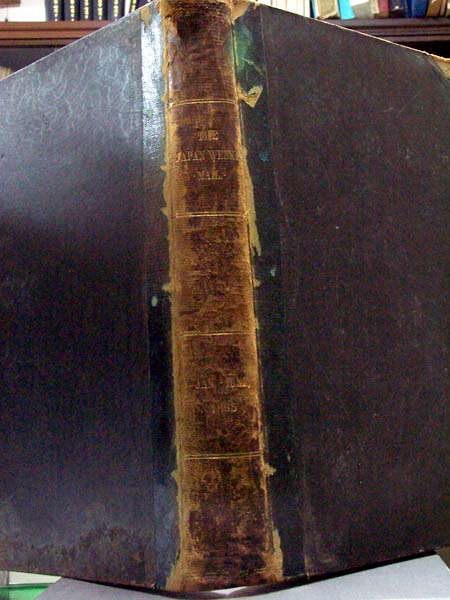
| |
舊韓末 정치상황을 자세히 보도한 英文版 日本新聞 6개월분 (1895년 1월 - 6월말). THE JAPAN WEEKLY MAIL (A Review of Japanese Commerce,Politics,Literature,and Art) January to June 1895./1895
Weekly Newspapers covering from the first day of January to the end of June ,1895.Three-Quarter Leather. Folio - over 12" - 15" tall. Book is bound in 3/4 leather and brown cloth with gilt lettering and bands to the spine.It contains 736 clean pages, It is full of news of the day ( politics, war etc. ) chess problems Yokohama Chess Club, Lists of Mail Steamers, Latest Shipping, Departures and Arrivals by name of passenger ( showing famous names in there ), latest commercial imports and exports etc..........................................
Bearing various articles(approx. 35 articles ) related to the Political situtation, News of the Court,News related to the Father of the King and Queen of
of the Kingdom of Korea ,Reforms,Assassinations,Tong Hak Farmer's revolution,
Foreign Loans of the Kingdom of Korea etc.etc. Extremely rare source on
the Kingom of Old Korea in the end of the 19th century.구한말 서울에 주재했던 일본유수의 신문의 특파원들이 전하는 高宗皇帝,大院君,明成皇后,고위정치인 암살사건, 宮中의 動情,舊韓末의 財政,일본에서 출국하는 국내외 고위인사,일본으로 입국하는 국내외 고위인사의 출국일 입국일,출항하는 기선과 시간,입항하는 기선과 시간
등등이 상세하게 보도되고 있슴.
표시언어 English.
초판. |
The Japan Weekly Mail,Yokohama,Japan |
영어 |
. |
초판 |
7,800,000 원
|
|
|
|
| 3589 |
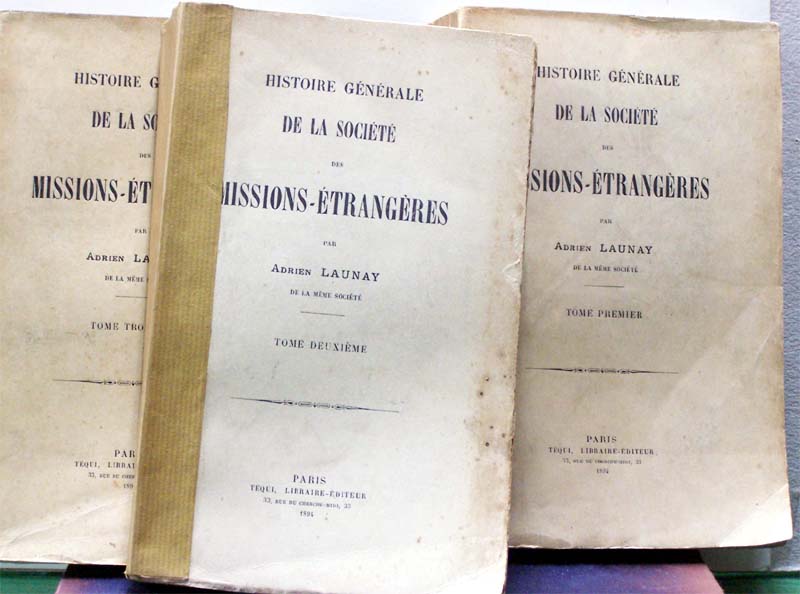
| |
파리 外邦傳敎會全史 (全3권) 조선자료다수포함.Histoire Generale de la Societe des MISSIONS-ETRANGERES.1894년 초판./1894
Histoire Generale de la Societe des MISSIONS-ETRANGERES
Softcover in 3 volumes.8 vo. Paperbound. 595, 594, 646 pages. First edition.
Many references to history of Catholic church in Korea.저자는 파리외방전교회 고문서
보관소에서 근무했던, 당시 한국의 천주교 사정에 정통했던 Adrien Launay로 곳곳에
한국관계 자료가 보이며 한국의 천주교연구에 필수적인 자료임.하드커버로 재장정했음.
표시언어 french. 초판.
--------------------------------------------------------
Histoire Generale de la Societe des MISSIONS-ETRANGERES(General History of the Society of Foreign Missions of Paris)/1894
Softcover in 3 volumes.8 vo. Paperbound. 595, 594, 646 pages. First edition. Many references to history of Catholic church in Korea................................. Society of Foreign Missions of Paris The Society of Foreign Missions of Paris was established in 1658-63, its chief founders being Mgr Pallu, Bishop of Heliopolis, Vicar Apostolic of Tongking, and Mgr Lambert de la Motte, Bishop of Bertyus, Vicar Apostolic of Conchin-China. Both bishops left France (1660-62) to go to their respective missions and as true travellers of Christ they crossed Persia and India on foot. The object of the new society was and is still the evangelization of infidel countries, by founding churches and raising up a native clergy under the jurisdiction of the bishops. In order that the society might recruit members and administer its property, a house was established in 1663 by the priests whom the vicars Apostolic had appointed their agents. This house, whose directors were to form young priests to the apostolic life and transmit to the bishops the offerings made by charity, was, and is still situated in Paris in the Rue de Bac. Known from the beginning as the seminary of Foreign Missions, its secured the approval of Alexander VII, and the legal recognition, still in force, of the French Government. The nature and organization of the society deserves special mention. It is not a religious order but a congregation, a society of secular priests, united as members of the same body, not by vows but by the rule approved by the Holy See, by community of object, and the seminary of Foreign Missions, which is the centre of the society and the common basis which sustains the other parts. On entering the society the missionaries promise to devote themselves until death to the service of the missions, while the society assures them in return, besides the means of sanctification and perseverance, all necessary temporal support and assistance. There is no superior general; the bishops, vicars Apostolic, superiors of missions and board of directors of the seminary are the superiors of the society. The directors of the seminary are chosen from among the missionaries and each group of missions is represented by a director. The bishops and vicars Apostolic are appointed by the pope, after nomination by the missionaries, and presentation by the directors of the seminary. In their missions they depend only on Propaganda and through it on the pope. No subject aged more than thirty-five may be admitted to the seminary nor may anyone become a member of the society before having spent three years in the mission field. Several points of this rule were determined from the earliest year of the society's existence, and others were established by degrees and as experience pointed out their usefulness. By this rule the society has lived and according to it its history has been outlined. This history is difficult, for owing to the length of the journeys, the infrequent communication, and the poverty of resources the missions have developed with difficulty. The chief events of the first period (1658-1700) are: the publication of the book "Institutions apostoliques", which contains the germ of the principles of the rule, the foundation of the general seminary at Juthia, (Siam), the evangelization of Tongking, Cochin China, Cambodia, and Siam, where more than 40,000 Christians were baptized, the creation of an institute of Annamite nuns known as "Lovers of the Cross", the establishment of rules among catechists, the ordination of thirty native priests. Besides these events of purely religious interest there were others in the political order which emphasized the patriotism of these evangelical labourers: through their initiative a more active trade was established between Indo-China, the Indies, and France; embassies were sent from place to place; treaties were signed; a French expedition to Siam took possession of Bangkok, Mergin, and Jonselang, and France was on the verge of possessing an Indo-Chinese empire when the blundering of subalterns ruined an undertaking the failure of which had an unfortunate influence on the missions. But the most important work of the vicars Apostolic and the society is the application of the fruitful principle of the organization of churches by native priests and bishops. Thenceforth the apostolate in its progress has has followed this plan in every part of the world with scrupulous fidelity and increasing success. In the second half of the eighteenth century it was charged with the missions which the Jesuits had possessed in India prior to their suppression in Portugal. Many of the Jesuits remained there. The missions thereupon assumed new life, especially at Setchoan, where remarkable bishops, Mgr Pottier and Mgr Dufresse, gave a strong impulse to evangelical work; and in Cochin China, where Mgr Pineau de Behaine performed signal service for the king of that country as his agent in making with France a treaty, which was the first step towards the splendid situation of France in Indo-China. At the end of the eighteenth century the French revolution halted the growth of the society, which had previously been very rapid. At that time it had six bishops, a score of missionaries, assisted by 135 native priests; in the various missions there were nine seminaries with 250 students, and 300,000 Christians. Each year the number of baptisms rose on a average of 3000 to 3500; that of infant baptisms in articulo mortis was more than 100,000. In the nineteenth century the development of the society and its missions was rapid and considerable. Several causes contributed to this; chiefly the charity of the Propagation of the Faith and the Society of the Holy Childhood; each bishop receives annually 1200 francs, each mission has its general needs and works allowance, which varies according to its importance, and may amount to from 10,000 to 30,000 francs. The second cause was persecution. Fifteen missionaries died in prison or were beheaded during the seventeenth and eighteenth centuries and the beginning of the nineteenth century; but after that the martyrs among the missionaries were very numerous. The best known are Mgr Dufresse, vicar Apostolic of Se-tchoan, beheaded in 1815; Gagelin, Marchand, Jaccard, Cornay, and Dumoulin-Borie from 1833 to 1838; and from 1850 to 1862 Schoeffler, Vénard, Bonnard, Néron, Chapdelaine, Néel, Cuenot, vicar Apostolic of Eastern Cochin China. If, besides these, mention were made of the native priests, catechists, and nuns, in short of all who died for Christ, we should have a record of one of the bloodiest holocausts in history. These persecutions were described in Europe by books, pamphlets, annals, and journals, arousing the pity of some and the anger of others, and inspiring numerous young men either with the desire or martyrdom or that of evangelization. They moved European nations, especially France and England, to intervene in Indo-China and China, and open up in these countries an era of liberty and protection till then unknown. Another cause of the progress of the missionaries was the ease and frequency of communication in consequence of the invention of steam and the opening of the Suez Canal. A voyage could be made safely in one month which formerly required eight to ten months amid many dangers. The following statistics of the missions confided to the Society will show this development at a glance: Missions of Japan and Korea — Tokio, Nagasaki, Osaka, Hakodate, Korea, total number of Catholics, 138,624; churches or chapels, 238; bishops and missionaries, 166; native priests, 48; catechists, 517; seminaries, 4; seminarists, 81; communities of men and women, 44, containing 390 persons; schools, 161, with 9024 pupils; orphanages and work-rooms, 38, with 988 children; pharmacies, dispensaries, and hospitals, 19. Missions of China and Tibet — Western, Eastern, and Southern Se-tchoan, Yun-nan, Kouy-tcheou, Kouang-ton, Kouang-si, Southern Manchuria, Northern Manchuria. — Catholics, 272,792; churches or chapels, 1392; bishops and missionaries, 408; native priests, 191; catechists, 998; seminaries, 19; seminarists, 661; communities of men and women, 23, with 222 members; schools, 1879, with 31,971 pupils; orphanages and work-rooms, 132, with 4134 children; pharmacies, dispensaries, and hospitals, 364. Missions of Eastern Indo-China — Tongking, Cochin China, Cambodia — Catholic population, 632,830; churches or chapels, 2609; bishops and missionaries, 365; native priests, 491; catechists, 1153; seminaries, 14; seminarists, 1271; communities of men and women, 91, with 2538 persons; schools, 1859, with 58,434 pupils; orphanages and work-rooms, 106, with 7217 children; pharmacies, dispensaries, and hospitals, 107. Missions of Western Indo-China — Siam, Malacca, Laos, Southern Burma, Northern Burma — Catholics, 132,226; churches or chapels, 451; bishops and missionaries, 199; native priests, 42; catechists, 242; seminaries, 3; seminarists, 81; communities of men and women, 47, with 529 members; schools, 320, with 21,306 pupils; orphanages and work-rooms, 132, with 3757 children; pharmacies, dispensaries, and hospitals, 86. Missions of India — Pondicherry, Mysore, Coimbatore, Kumbakonam. — Catholics, 324,050; churches or chapels, 1048; bishops and missionaries, 207; native priests, 67; catechists, 274; seminaries, 4; seminarists, 80; communities of men and women, 54, with 787 members; schools, 315, with 18,693 pupils; orphanages and work-rooms, 57, with 2046 children; pharmacies, dispensaries, and hospitals, 41. In addition to these missionaries actively engaged in mission work, there are some occupied in the establishments called common, because they are used by the whole society. Indeed the development of the society necessitated undertakings which were not needed in the past. Hence a sanatorium for sick missionaries has been established at Hong-Kong on the coast of China; another in India among the Nilgiri mountains, of radiant appearance and invigorating climate, and a third in France. In thinking of the welfare of the body, that of the soul was not lost sight of, and a house of spiritual retreat was founded at Hong-Kong, wither all the priests of the society may repair to renew their priestly and apostolic fervour. To this house was added a printing establishment whence issue the most beautiful works of the Far East, dictionaries, grammars, books of theology, piety, Christian doctrine, and pedagogy. Houses of correspondence, or agencies, were established in the Far East, at Shanghai, Hong-Kong, Saigon, Singapore, and one at Marseilles, France. The Seminary of the Foreign Missions which long had only one section, has for twenty years had two. |
Adrien Launay |
불어 |
Tequi,Libaire-Editeur .Paris |
초판 |
2,000,000 원
|
|
|
[1]2 |
|
|